[orc]More than 1.3 lakh people committed suicide in the year 2016 as per the recent ADSI-2016 report released by the NCRB. More than 25000 of these suicides were of ‘Daily Wage Earner’. Second in the list is ‘House Wives’ who accounted for more than 16% of the suicides. It has to be noted that the profession of the victim may not be related to the cause of the suicide.
Accidental Deaths and Suicides in India (ADSI) -2016, published by National Crime Records Bureau states that a total of 1,31,008 suicides were committed across India during 2016.
There are various factors and situations which lead to suicides. The ADSI report, which NCRB has been publishing since 1967, provides data on various aspects related to suicides, like – the age group, profession, socio economic profile etc. This offers useful insights in understanding the trends related to the nature of suicides.
In this story, we look at suicides in the context of the profession. It has to be noted that , the data records only the profession of the person committing suicide and the cause for the suicide might not be related to the profession.
Number of Suicides in 2016 less than previous year, but still higher than 10 years ago
The trend in the number of suicides committed in India has been inconsistent. The year 2010 saw the highest increase in the number of suicides over the previous year (increase of 7,448 suicides). The following year i.e. 2011, recorded the highest number of suicides in the decade with 1,35,585 suicides. After a marginal declining trend over the next few years, the number of suicides increased in 2015 to 1.33 lakh and a fell in the subsequent year of 2016. Ten years ago, in 2007, 1.23 lakh suicides were recorded.
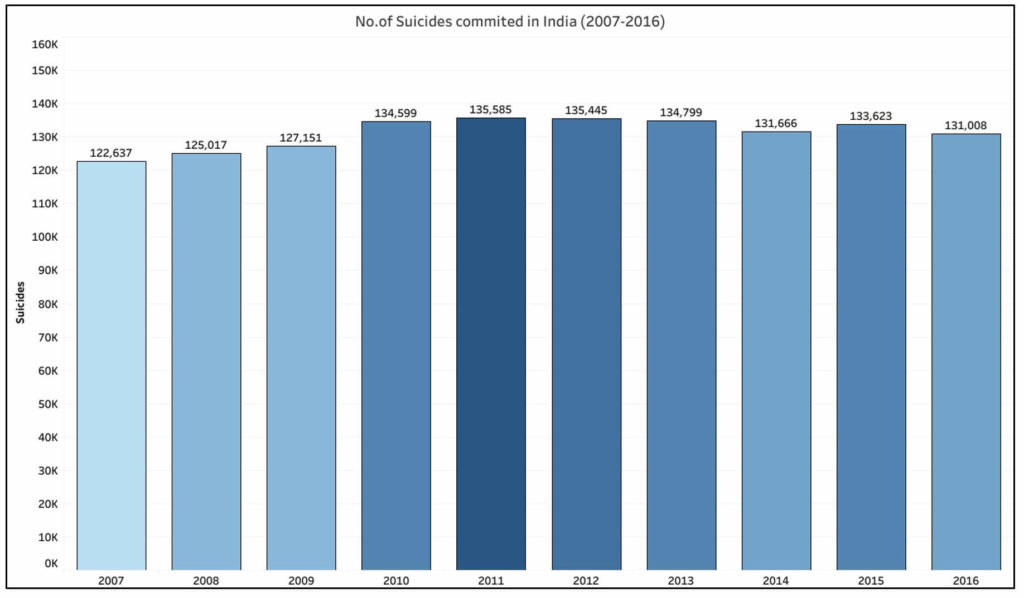
Rate of Suicides in 2016 at the lowest in 10 years
During the 10-year period from 2007-2016, the population grew from 113.6 crores in 2007 to 127.4 crores in 2016 ( this is a mid-year, projected population estimate). This implies that the rate of suicides in 2007 was 10.8 (per one lakh population), which after an increase in 2010,has seen a subsequent decline over the years and is at 10.3 in 2016.
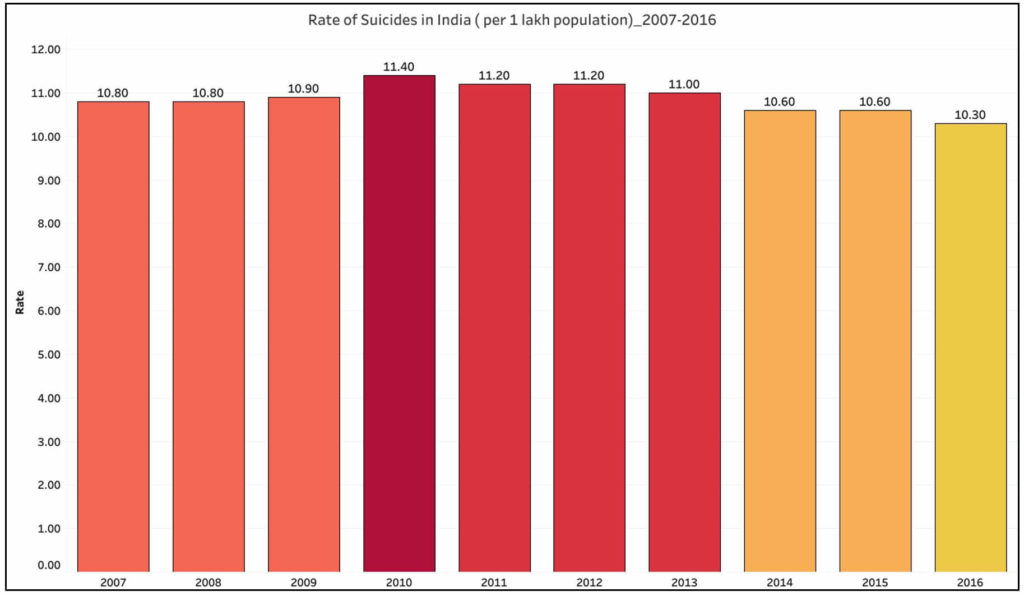
Daily Wage Earners account for the highest share of suicides in 2016
Categorised by profession, the highest number of suicides were committed by ‘Daily Wage Earners’ in 2016. A total of 25,164 suicides were of daily wage earners i.e. 19.2% of the total suicides in 2016. These daily wage earners do not include Agricultural labourers.
Second in the list with 16.5% of the total suicides in 2016 is the category of ‘House wife’. A total of 21,563 individuals who committed suicide were identified as a House wife . Self-employed individuals accounted for a total of 13,507 suicide cases i.e. 10.3% of the total. A major portion these self-employed individuals own businesses. 11,379 individuals engaged in farming activities as cultivators and agricultural labourers committed suicide in 2016.
While professionals/salaried employees constitute 7.9% of the total suicides in 2016, the highest number of suicides were of a separate category of Daily wage earners which was introduced only in 2014. Their share in the total number of suicides has been increasing every year. In 2014, 15,735 suicides were categorised as of daily wage earners which constituted 12% of the total. In 2015 , the number increased to 23,799 or 17.8% and in 2016, their share in the total suicides went up to 19.2%.
While there could be other factors which have contributed towards the higher incidence of suicides among daily wage earners, the economic stress and associated factors could be one of the key influencers. Unemployed individuals also have a higher incidence with 8.3% of the total suicides in 2016.
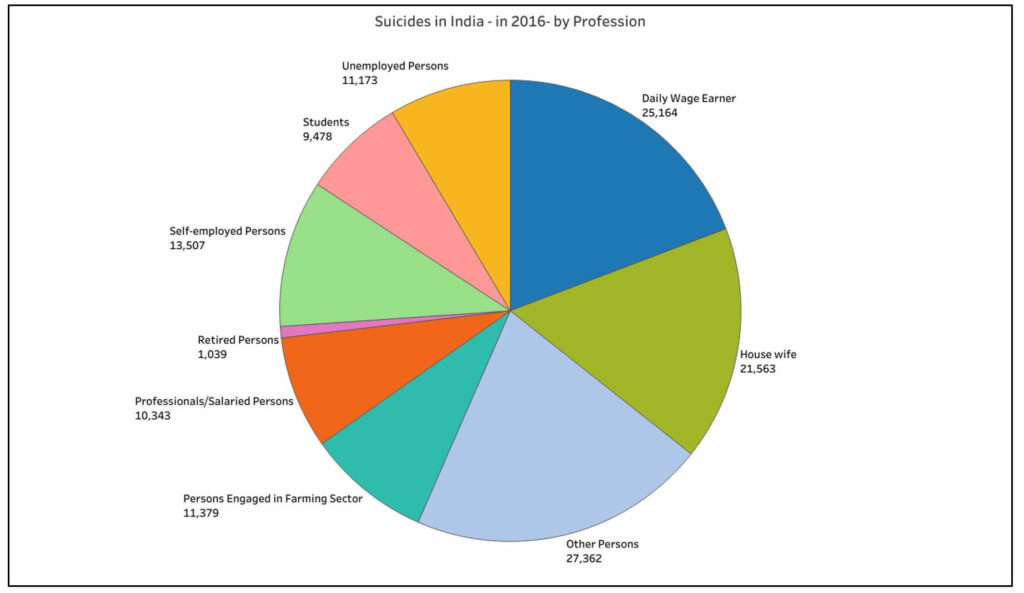
Number of suicides of persons engaged in Farming sector has decreased over the last 10 years
Of the total suicides committed in India during 2016, 11,379 i.e. 8.7% were of persons engaged in the farming sector. As stated earlier in the story, the reasons behind committing suicides might not be farm related distress, and there could be other factors for suicides.
In 2007, persons engaged in farming sector constituted 13.6% of the total suicides in India. The highest share was in 2009, with 13.7%. In the subsequent years, the share has substantially reduced. In the years 2014 and 2015, there was an increase in the share of suicides of persons engaged in farming sector. The highest number of suicides of persons engaged in farming activities in the past 10 years was in 2009 with 17,368 suicides.
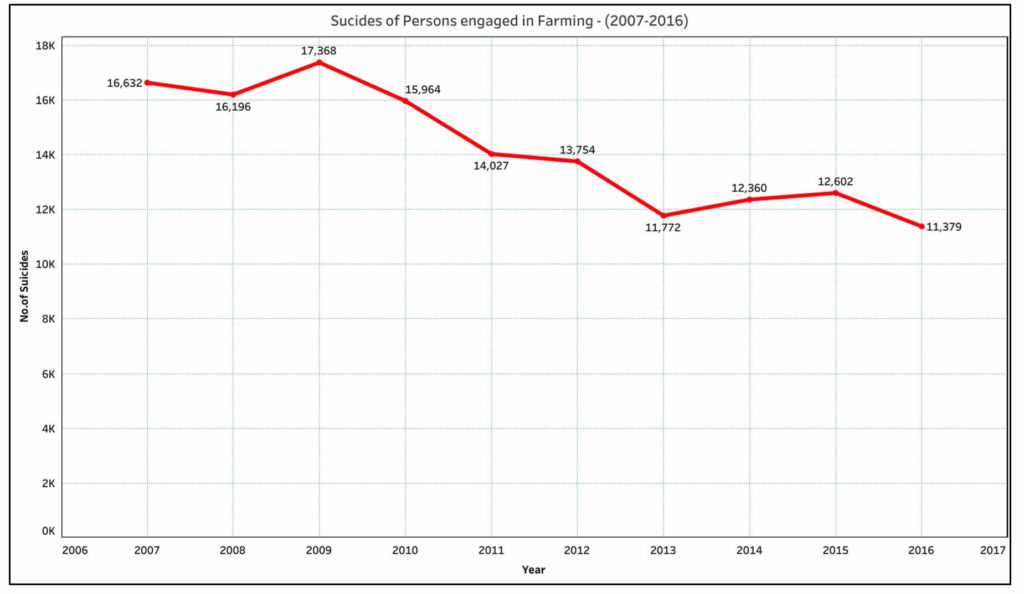
Prior to 2014, the ADSI report included ‘farming/agriculture’ as a sub category of ‘Self-Employment’. However, since 2014, not only a separate category ‘Persons Engaged in Farming Sector’ was introduced but also a further break up was provided. This includes – Farmers/Cultivators who own land, Farmers/Cultivators who use leased land and Agricultural labourers.
Suicides among the farmers working on leased land, albeit less has increased over the three years. The number of suicides among the agricultural labourers has increased compared to the previous year. Factly had earlier written a detailed story on the state of such suicides.
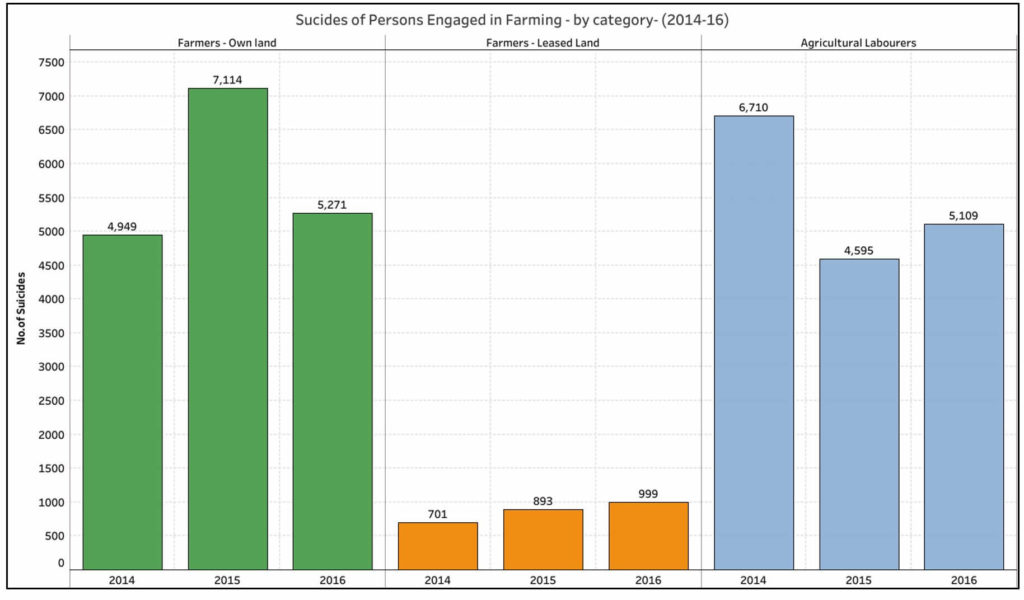
Increase in the number of Suicides among Students and Unemployed
Year 2016 recorded the highest number of suicides among the unemployed in the last 10 years. Out of the total suicides committed in 2016, 11,173 were of unemployed i.e. 8.5% of the total. Since 2012, when the number of suicides was 8,927 there has been a consistent increase in the number of suicides among unemployed every year. Although the population of India has also grown during this period, the worrying aspect is the consistent increase in the share of suicides of unemployed over the past few years. In 2013, suicides among unemployed were 7.2% of the total suicides and increased every subsequent year i.e. 7.5%, 8.2% and 8.5% in 2014, 2015 and 2016 respectively.
The share of suicides of students out of the total has also been constantly increasing since 2008. In 2008, the share of student suicides was 4.8% which has increased nearly every year (except 2012). In 2016, students’ suicides were 7.2% of the total.
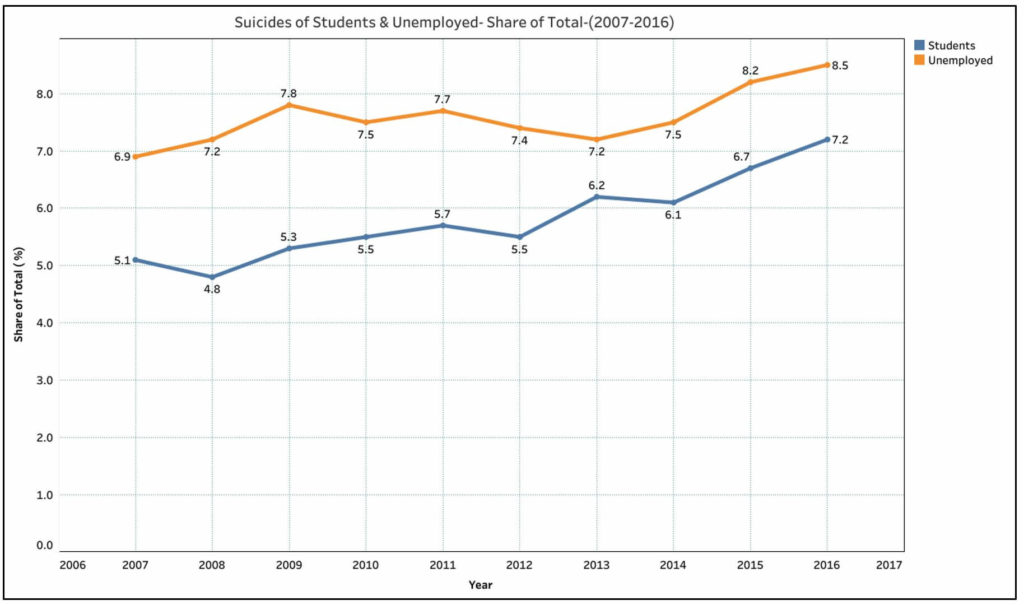
The total number of students who committed suicides in 2016 was 9,478 which is the highest in the last 10 years. While the profession of these suicides is given as ‘students’, the cause of the suicide might not be related to only their education. However, as per ADSI Report’s data relating to the cause of suicide, 2,408 suicides were reported as caused due to ‘failure in examination’, implying there are other reasons which have prompted suicides among students.
Similarly, 2298 cases were recorded as ‘Unemployment’ as a cause while a total of 11,173 unemployed individuals committed suicide in 2016.
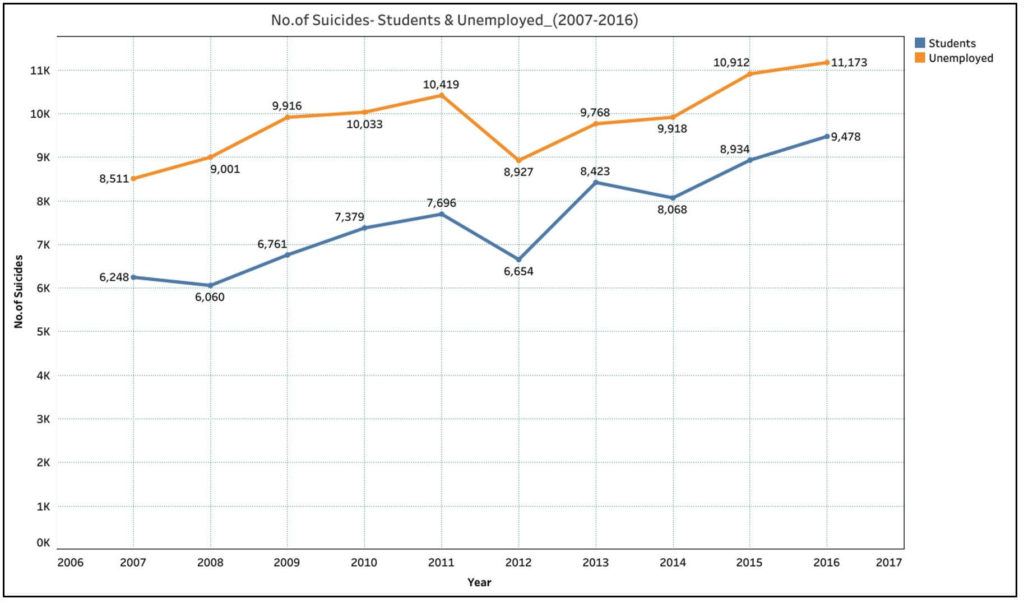
Share of suicides of individuals working in private sector has reduced over the years
The overall share of suicides of individuals in various forms of employment (other than farming) has come down over the last 10 years.
In 2007, 8.2% of the total suicides were of private sector employees. It was high in 2012 and 2013 with 9.4% and 9.2% respectively. However, over the past three years, there is a drastic decrease with suicides of private sector employees accounting for only 5.2% in 2016. In absolute numbers, there were 10,068 suicides of private employees in 2007 which reduced to 6,761 in 2016.
Meanwhile, the number of suicides of persons engaged in business has increased, though the situation has improved in the last two years. In 2014, there were 9,894 suicide cases of persons in business which was 7.5% of the total suicides in that year.
As noted earlier in the story, housewives form the highest share among the total suicides, after daily wage labourers. Although their share has come down compared to 10 years ago, the numbers are still high. In 2007, the number of housewives who committed suicide was 24,162 and was 19.7% of the total. Over the next few years, although there was marginal drop in the share, the absolute numbers were on an increasing trajectory. In 2017, a total of 21,563 housewives committed suicide.

Ambiguity on ‘Others’ who form the largest share does not provide a complete picture
Nearly 21% of the suicides are not categorized under any of the profession categories in the report. The profession categories provided themselves are broad classifications, which accommodate most of the professional pursuits, including the cases where the persons are unemployed or students. The ‘Others’ could therefore be a result of information missing while a case is being recorded.
However, a review of recent reports indicates an effort to provide more clarity in terms of profession. For example, the categorization of person engaged in farming, which offers better insights than earlier.
As already stated earlier, these numbers indicate only the profession of the person who committed suicide and not necessarily profession being the reason for suicide. Analysing these details in the light of other parameters like cause, socio-economic status etc. could offer better insights.
Featured Image: Suicides in India



1 Comment
Pingback: 46% of the Suicides in 2016 were due to Family Problems & Illness - Fact Checking Tools | Factbase.us